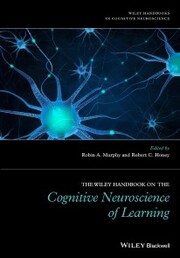Detailansicht
The Wiley Handbook on the Cognitive Neuroscience of Learning
eBook
ISBN/EAN: 9781118650851
Umbreit-Nr.: 9488840
Sprache:
Englisch
Umfang: 552 S., 17.11 MB
Format in cm:
Einband:
Keine Angabe
Erschienen am 26.05.2016
Auflage: 1/2016
E-Book
Format: EPUB
DRM: Adobe DRM
- Zusatztext
- <i>The Wiley Handbook on the Cognitive Neuroscience of Learning</i> charts the evolution of associative analysis and the neuroscientific study of behavior as parallel approaches to understanding how the brain learns that both challenge and inform each other.<br /><br /><ul><li>Covers a broad range of topics while maintaining an overarching integrative approach</li><li>Includes contributions from leading authorities in the fields of cognitive neuroscience, associative learning, and behavioral psychology</li><li>Extends beyond the psychological study of learning to incorporate coverage of the latest developments in neuroscientific research</li></ul>
- Kurztext
- The Wiley Handbook on the Cognitive Neuroscience of Learning charts the evolution of associative analysis and the neuroscientific study of behavior as parallel approaches to understanding how the brain learns that both challenge and inform each other. Covers a broad range of topics while maintaining an overarching integrative approach Includes contributions from leading authorities in the fields of cognitive neuroscience, associative learning, and behavioral psychology Extends beyond the psychological study of learning to incorporate coverage of the latest developments in neuroscientific research
- Autorenportrait
- <p>About the Contributors vii</p><p>Preface x</p><p>1 The Cognitive Neuroscience of Learning: Introduction and Intent 1<br /><i>Robert C. Honey and Robin A. Murphy</i></p><p><b>Part I Associative Learning 5</b></p><p>2 The Determining Conditions for Pavlovian Learning: Psychological and Neurobiological Considerations 7<br /><i>Helen M. Nasser and Andrew R. Delamater</i></p><p>3 Learning to Be Ready: Dopamine and Associative Computations 47<br /><i>Nicola C. Byrom and Robin A. Murphy</i></p><p>4 Learning About Stimuli That Are Present and Those That Are Not: Separable Acquisition Processes for Direct and Mediated Learning 69<br /><i>Tzu-Ching E. Lin and Robert C. Honey</i></p><p>5 Neural Substrates of Learning and Attentive Processes 86<br /><i>David N. George</i></p><p>6 Associative Learning and Derived Attention in Humans 114<br /><i>Mike Le Pelley, Tom Beesley, and Oren Griffiths</i></p><p>7 The Epigenetics of Neural Learning 136<br /><i>Zohar Bronfman, Simona Ginsburg, and Eva Jablonka</i></p><p><b>Part II Associative Representations Memory, Recognition, and Perception 177</b></p><p>8 Associative and Nonassociative Processes in Rodent Recognition Memory 179<br /><i>David J. Sanderson</i></p><p>9 Perceptual Learning: Representations and Their Development 201<br /><i>Dominic M. Dwyer and Matthew E. Mundy</i></p><p>10 Human Perceptual Learning and Categorization 223<br /><i>Paulo F. Carvalho and Robert L. Goldstone</i></p><p>11 Computational and Functional Specialization of Memory 249<br /><i>Rosie Cowell, Tim Bussey, and Lisa Saksida</i></p><p><b>Space and Time 283</b></p><p>12 Mechanisms of Contextual Conditioning: Some Thoughts on Excitatory and Inhibitory Context Conditioning 285<br /><i>Robert J. McDonald and Nancy S. Hong</i></p><p>13 The Relation Between Spatial and Nonspatial Learning 313<br /><i>Anthony McGregor</i></p><p>14 Timing and Conditioning: Theoretical Issues 348<br /><i>Charlotte Bonardi, Timothy H. C. Cheung, Esther Mondragón, and Shu K. E. Tam</i></p><p>15 Human Learning About Causation 380<br /><i>Irina Baetu and Andy G. Baker</i></p><p><b>Part III Associative Perspectives on the Human Condition 409</b></p><p>16 The Psychological and Physiological Mechanisms of Habit Formation 411<br /><i>Nura W. Lingawi, Amir Dezfouli, and Bernard W. Balleine</i></p><p>17 An Associative Account of Avoidance 442<br /><i>Claire M. Gillan, Gonzalo P. Urcelay, and Trevor W. Robbins</i></p><p>18 Child and Adolescent Anxiety: Does Fear Conditioning Play a Role? 468<br /><i>Katharina Pittner, Kathrin Cohen Kadosh, and Jennifer Y. F. Lau</i></p><p>19 Association, Inhibition, and Action 489<br /><i>Ian McLaren and Frederick Verbruggen</i></p><p>20 Mirror Neurons from Associative Learning 515<br /><i>Caroline Catmur, Clare Press, and Cecilia Heyes</i></p><p>21 Associative Approaches to Lexical Development 538<br /><i>Kim Plunkett</i></p><p>22 Neuroscience of Value?]Guided Choice 554<br /><i>Gerhard Jocham, Erie Boorman, and Tim Behrens</i></p><p>Index 592</p>
